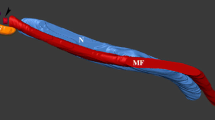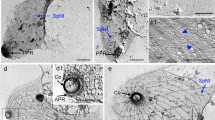Abstract
Giardia lamblia is a parasite possessing a complex cytoskeleton and an unusual morphology of bearing two nuclei. Here, the interphasic nuclei of trophozoites, using field emission scanning electron microscopy, routine scanning and transmission electron microscopy, immunocytochemistry, and 3D reconstruction, are presented. An approach using plasma-membrane extraction allowed the observation of the two nuclei still attached in their original positions. The observations are as follows: (1) Giardia nuclei and cytoskeleton were studied in demembranated cells by routine scanning electron microscopy and field emission; (2) both nuclei are anchored to basal bodies of the anterior flagella and to the descending posterior-lateral and ventral flagella, at the right and left nuclei, respectively, in cells attached by its ventral disc; (3) this attachment occurs by proteinaceous links, which were labeled by anti-actin and anti-centrin but not by anti-dynein or anti-tubulin antibodies; (4) fibrilar connections between the nuclei and the disc were also observed; and (5) nuclei exhibited a pendular movement when living cells were treated with cytochalasin, although the nuclei were still connected by their anterior region. Our analysis indicated that the nuclei have a defined position, and fibrils perform an anchoring system. This raises the possibility of a mechanism for nuclei-fidelity migration during mitosis.











Similar content being viewed by others
References
Adam RD (2001) Biology of Giardia lamblia. Clin Microbiol Rev 14:447–475
Apkarian RP (1997) The fine structure of fenestrated adrenocortical capillaries revealed by in-lens field-emission scanning electron microscopy and scanning transmission electron microscopy. Scanning 19:361–367
Benchimol M (2004) Participation of the adhesive disc during karyokinesis in Giardia lamblia. Biol Cell 96:291–301
Benchimol M, Piva B, Campanati L, De Souza W (2004) The funis of Giardia lamblia by high-resolution field emission scanning electron microscopy—new insights. J Struct Biol 96:291–301
Campanati L, Troster H, Monteiro-Leal LH, Spring H, Trendelenburg MF, De Souza (2003) Tubulin diversity in trophozoites of Giardia lamblia. Histochem Cell Biol 119:323–331
Cole NB, Lippincott-Schwartz J (1995) Organization of organelles and membrane traffic by microtubules. Curr Opin Cell Biol 7:55–64
Corrêa G, Diaz JM, Benchimol M (2004) Centrin in Giardia lamblia—ultrastructural localization. FEMS 233:91–96
Diamond LS, Harlow D, Cunnick CC (1978) A new medium for the axenic cultivation of Entamoeba histolytica and other Entamoeba. Trans R Soc Trop Med Hyg 72:431–432
Elmendorf GH, Dawson SC, McCaffery JM (2003) The cytoskeleton of Giardia lamblia. Int J Parasitol 33:3–28
Erlandsen SL, Rasch EM (1994) The DNA content of trophozoites and cysts of Giardia lamblia by microdensitometric quantitation of Feulgen staining and examination by laser scanning confocal microscopy. J Histochem Cytochem 42:1413–1416
Feely DE, Erlandsen SL, Chase DG (1984) Structure of the trophozoite and cyst. In: Erlandsen SL, Meyer EA (eds) Giardia and Giardiasis: biology, pathogenesis and epidemiology. Plenum, New York, pp 3–31
Feely DE, Erlandsen SL, Chase DG, Holberton DV, Erlandsen SL (1990) The biology of Giardia. In: Meyer EA (ed) Giardiasis. Elsevier, Amsterdam, pp 11–49
Ghosh S, Frisardi M, Rogers R, Samuelson J (2001) How Giardia swim and divide. Infect Immun 69:7866–7872
Gillin FD, Boucher SE, Rossi SS, Reiner DS (1989) Giardia lamblia: the roles of bile, lactic acid and pH in completion of the life cycle in vitro. Exp Parasitol 69:164–174
Gillin FD, Reiner DS, McCaffery JM (1996) Cell biology of the primitive eukaryote Giardia lamblia. Ann Rev Microbiol 50:679–705
Heath B (1981) Nucleus-associated organelles in fungi. Int Rev Cytol 69:191–221
Kabnick KS, Peattie DA (1990) In situ analyses reveal that the two nuclei of Giardia lamblia are equivalent. J Cell Sci 95:353–360
Keister DB (1983) Axenic culture of Giardia lamblia in TYI-S-33 medium supplemented with bile. Trans R Soc Trop Med Hyg 77:487–488
Lanfredi-Rangel A, Attias M, DeCarvalho TM, Kattenbach WM, DeSouza W (1998) The peripheral vesicles of trophozoites of the primitive protozoan Giardia lamblia may correspond to early and late endosomes and to lysosomes. J Struct Biol 123:225–235
Lujan HD, Marotta A, Mowatt MR, Sciaky N, Lippincott-Schwartz J, Nash TE (1995) Developmental induction of Golgi structure and function in the primitive eukaryote Giardia lamblia. J Biol Chem 270:4612–4618
Melkonian M, Beech PL, Katsaros C, Schulze D (1992) Centrin-mediated cell motility in algae. In: Melkonian M (ed) Algal cell motility. Chapman & Hall, New York, pp 179–221
Moody D, Lozanoff S (1997) SURF driver, a practical computer program for generating three-dimensional models of anatomical structures. Paper presented at the 14th annual meeting of the American Association of Clinical Anatomists, Honolulu, Hawaii, 8–11 July 1997
Nohýnková E, Dráber P, Reischig J, Kulda J (2000) Localization of gamma-tubulin in interphase and mitotic cells of a unicellular eukaryote, Giardia intestinalis. Eur J Cell Biol 79:438–445
Pawley J (1997) The development of field-emission scanning electron microscopy for imaging biological surfaces. Scanning 19:324–336
Peters KR (1979) Scanning electron microscopy at macromolecular resolution in low energy mode on biological specimens coated with ultra thin metal films. Scan Electron Microsc 2:133–148
Reiner DS, McCaffery JM, Reiner FD (1990) Sorting of cyst wall proteins to a regulated secretory pathway during differentiation of the primitive eukaryote, Giardia lamblia. Eur J Cell Biol 53:142–153
Robinson DR, Gull K (1991) Basal body movements as a mechanism for mitochondrial genome segregation in the trypanosome cell cycle. Nature 352:731–733
Robinson DR, Sherwin T, Ploubidou A, Byard EH, Gull K (1995) Microtubule polarity and dynamics in the control of organelle positioning, segregation, and cytokinesis in the Trypanosome cell cycle. J Cell Biol 128:1163–1172
Salisbury JL, Baron A, Surek B, Melkonian M (1984) A striated flagellar roots: isolation and partial characterization of a calcium-modulated contractile organelle. J Cell Biol 99:962–970
Schliwa M, van Blerkom J (1981) Structural interaction of cytoskeletal components. J Cell Biol 90:222–235
Schulze D, Robenek H, McFadden GI, Melkonian M (1987) Immunolocalization of a Ca2+—modulated contractile protein in the flagellar apparatus of green algae: the nucleus-basal body connector. Eur J Cell Biol 45:51–61
Solari AJ, Rahn MI, Saura A, Lujan HD (2003) A unique mechanism of nuclear division in Giardia lamblia involves components of the ventral disk and the nuclear envelope. Biocell 27:329–346
Upcroft J, Upcroft P (1998) My favorite cell: Giardia. Bioessays 20:256–263
Wiemer EAC, Wenzel T, Deerink TJ, Ellisman MH, Subramani S (1997) Visualization of the peroxisomal compartment in living mammalian cells: dynamic behavior and association with microtubules. J Cell Biol 136:71–80
Wiesehahn GP, Jarrol EL, Lindmark DG, Meyer EA, Hallick LM (1984) Giardia lamblia: autoradiographic analysis of nuclear division. Exp Parasitol 58:94–100
Woods A, Sherwin T, Sasse R, MacRae TH, Baines AJ, Gull K (1989) Definition of individual components within the cytoskeleton of Trypanosoma brucei by a library of monoclonal antibodies. J Cell Sci 93:491–500
Yu LZ, Birky WC Jr, Adam RD (2002) The two nuclei of Giardia each have complete copies of the genome and are partitioned equationally at cytokinesis. Eukaryotic Cell 1:191–199
Acknowledgements
This work was supported by the Conselho Nacional de Desenvolvimento Científico e Tecnológico (CNPq), Fundação Carlos Chagas Filho de Amparo à Pesquisa do Estado do Rio de Janeiro (FAPERJ), Programa de Núcleos de Excelência (PRONEX), Coordenação de Aperfeiçoamento de Pessoal de Nível Superior (CAPES), and Associação Universitária Santa Úrsula (AUSU).
Author information
Authors and Affiliations
Corresponding author
Rights and permissions
About this article
Cite this article
Benchimol, M. The nuclei of Giardia lamblia—new ultrastructural observations. Arch Microbiol 183, 160–168 (2005). https://doi.org/10.1007/s00203-004-0751-8
Received:
Revised:
Accepted:
Published:
Issue Date:
DOI: https://doi.org/10.1007/s00203-004-0751-8




